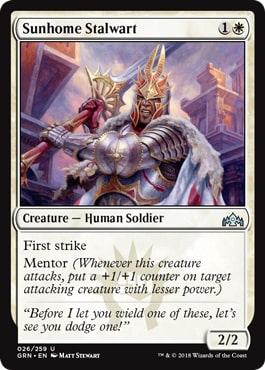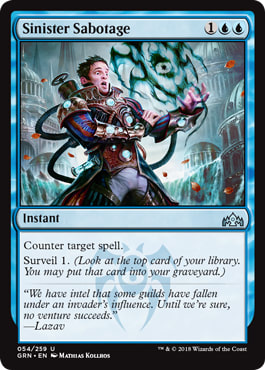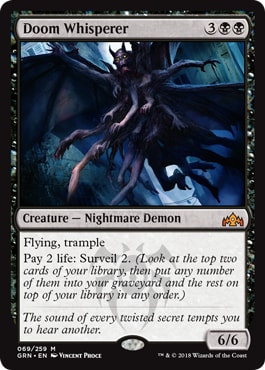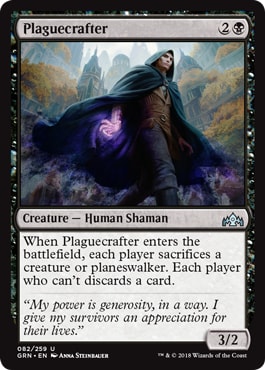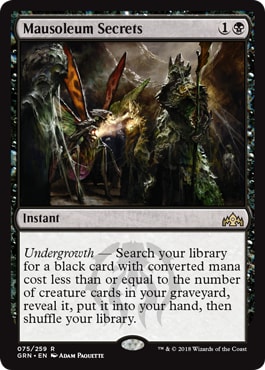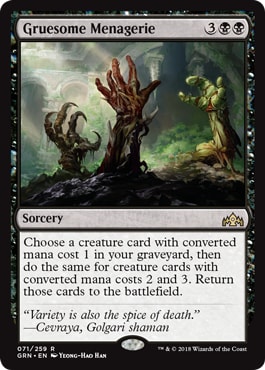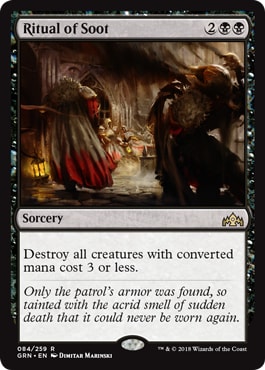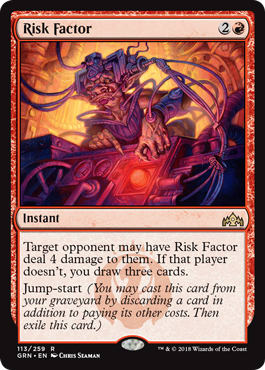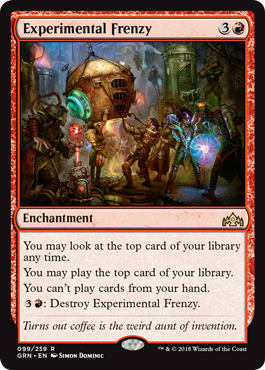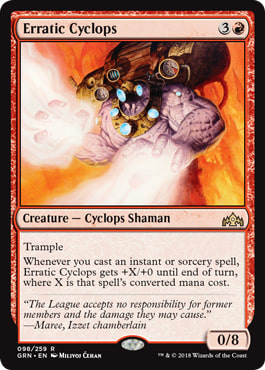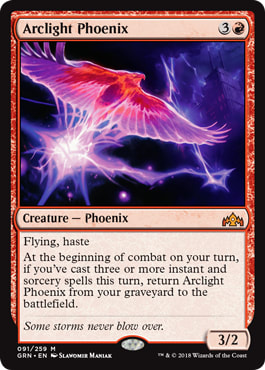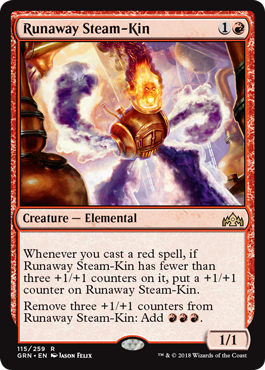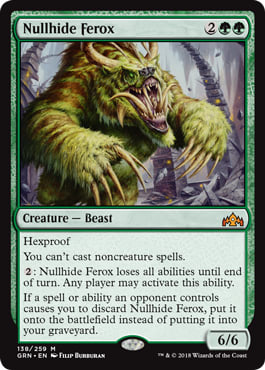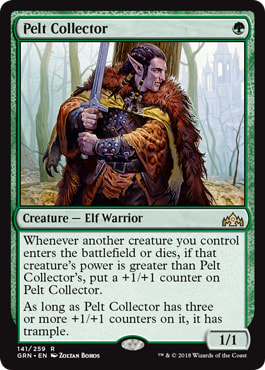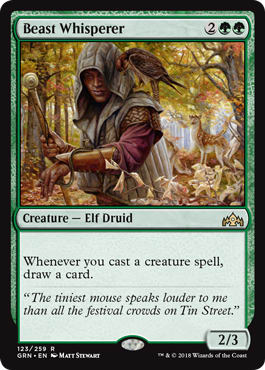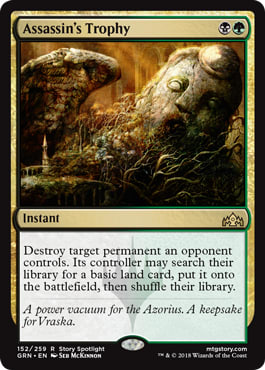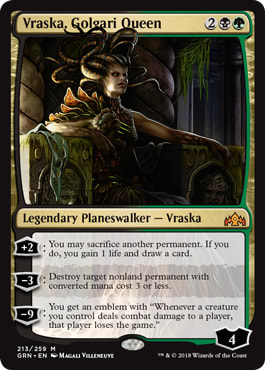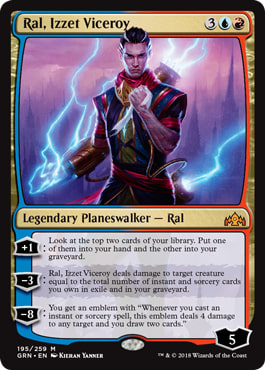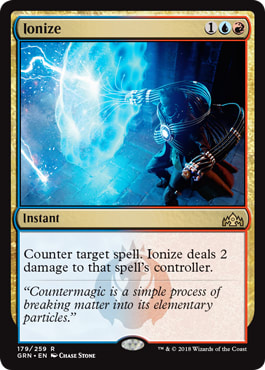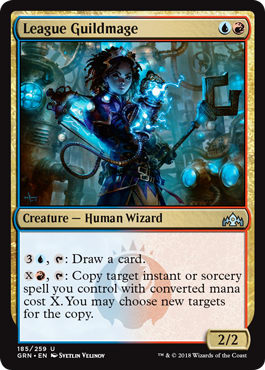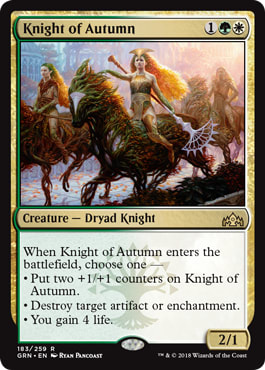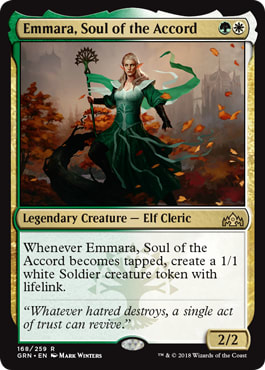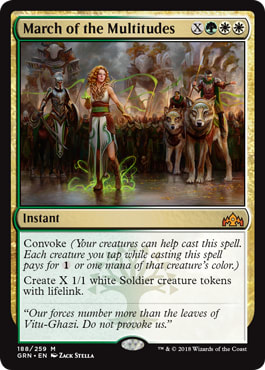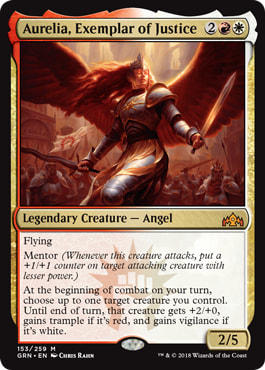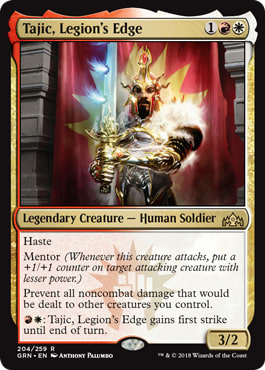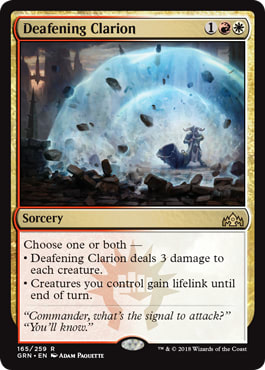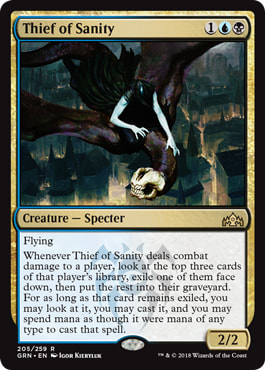Guilds of Ravnica is another set developed after the Play Design team was implemented, one with more Play Design impact but not full Play Design focus.
With Dominaria and Core Set 2019 giving us some great Cube options, this set is another hit for Cubes with a smattering of underrated and obvious additions.
Of note: Although this set review is being released after the Magic Online/MTG: Arena release and the initial formations of the online metagame through 5-0 decklists being published, know that these evaluations are based on actual play in my Cube and not merely outsourced to constructed formats. If I'm saying a card has been working well based on my experience, it's based on actual experience from trying them out in my Cube and finding the cards have been working well/poorly.
I'll be referencing decks (that won/had the best record) that utilize Guilds of Ravnica cards. Of course, a deck going 3-0 with a card in a deck isn't ironclad proof of a card being good, but I'll be citing how these cards have manifested in winning Cube decks.
White
Conclave Tribunal is this set's Banishing Light riff. We've seen recent ones like Cast Out and Quarantine Field, and while Conclave Tribunal looked to be one that worked well with casting small creatures and using them to power this out, I found that it was mediocre.
It usually felt overcosted and wasn't convoked incredibly often, and even decks that could convoke it found it to be just okay. Oddly, I've been a big fan of Stoke the Flames since day 1 in Cubes due to how well it lets Red decks efficiently utilize their resources - both Stoke and Tribunal are about one mana above base rate for this type of effect, but overall, Tribunal doesn't live up to Flames' example.
Bounty Agent fills a similar role to Remorseful Cleric, as a safety valve for commonly played Cube cards. Bounty Agent falls victim to similar pitfalls as Remorseful Cleric - which I talked in my Core Set 2019 Cube review as looking a lot better than it actually is. Although the adage that both of these cards "always hit something" rings somewhat true in terms of potential targets, the overall number of targets is generally lacking. I found most 3-0 decks only had a handful of targets, typically between 0-3.
There are intangible and qualitative benefits of having a safety valve like this in Cube, since the format has a myriad of threats and giving players an out to annoying things like Umezawa's Jitte, Search for Azcanta, and Kari Zev, Skyship Raider is nice, especially if they feel that these kinds of cards are problematic.
However, as Bounty Agent can't do anything about these those things until an uptap cycle, she isn't very good at stopping these kinds of permanents. Her body is also pretty bad by Cube standards in the year 2018 and her play experience tended to match this. It's pretty lackluster as a Cube aggro creature, and even worse in archetypes like midrange and control due to the lack of immediate impact.
Venerated Loxodon is underrated since it's being judged by its worst case, a White Durkwood Boars. Casting aside fear-based analysis of assuming the worst-case is the always-case, Loxodon generally plays a much more potent role in White aggro (and some midrange) decks.
The way that it has played out is similar to a small anthem that boosts smaller creatures, usually those that can't attack safely or have some form of evasion so that their impact is even higher on a board state. It can be cast on turn three on a dream curve with a 1-drop and a 2-drop helping to power it out, but I found that Venerated Loxodon tends to get cast on turns 4+ to boost smaller creatures while providing its own body as a threat. While it can be awkward to topdeck this without any other creatures to boost, it's still fine in those scenarios as a decently-sized beater. However, those worst-case scenarios don't tend to happen too often.
Like with Delve cards, it's hardly ever cast for the retail cost. It's hard to really quantify exactly where on the mana curve Venerated Loxodon fits, but I've liked it as a solid (but hardly staple status) booster for White aggro decks and aggressive-leaning midrange decks that have some warm bodies lying around. It's not bad in more midrangey decks that have random value creatures and walls lying around, either.
Sunhome Stalwart suffers in Cube since attacking 1-drops typically have two power, with a few exceptions in White: Student of Warfare, Legion's Landing's vampire token, and honorary defender Mother of Runes. Other aggro colors have a similar situation for 2-power 1-drops and I found that most successful aggro decks didn't have many creatures to boost:
Example Deck #1 | Cube | Usman Jamil
- Creatures (15)
- 1 Anafenza, Kin-Tree Spirit
- 1 Baneslayer Angel
- 1 Blade Splicer
- 1 Brimaz, King of Oreskos
- 1 Dauntless Bodyguard
- 1 Dryad Militant
- 1 Earthshaker Khenra
- 1 Glorybringer
- 1 Hallowed Spiritkeeper
- 1 Kitchen Finks
- 1 Kytheon, Hero of Akros
- 1 Leonin Relic-Warder
- 1 Mardu Woe-Reaper
- 1 Palace Jailer
- 1 Stoneforge Mystic
- Planeswalkers (2)
- 1 Ajani Goldmane
- 1 Elspeth, Knight-Errant
- Instants (3)
- 1 Lightning Helix
- 1 Magma Jet
- 1 Searing Spear
- Sorceries (1)
- 1 Insult // Injury
- Enchantments (1)
- 1 Oblivion Ring
- Artifacts (2)
- 1 Skullclamp
- 1 Sword of Feast and Famine
Example Deck #2 | Cube | Usman Jamil
- Creatures (16)
- 1 Blade Splicer
- 1 Bomat Courier
- 1 Etched Champion
- 1 Falkenrath Gorger
- 1 Figure of Destiny
- 1 Firedrinker Satyr
- 1 Kytheon, Hero of Akros
- 1 Memnite
- 1 Mother of Runes
- 1 Phyrexian Revoker
- 1 Pia and Kiran Nalaar
- 1 Porcelain Legionnaire
- 1 Rakdos Cackler
- 1 Scrapheap Scrounger
- 1 Selfless Spirit
- 1 Walking Ballista
- Planeswalkers (2)
- 1 Chandra, Torch of Defiance
- 1 Karn, Scion of Urza
- Instants (2)
- 1 Galvanic Blast
- 1 Unexpectedly Absent
- Sorceries (1)
- 1 Fiery Confluence
- Artifacts (5)
- 1 Heart of Kiran
- 1 Sensei's Divining Top
- 1 Sword of Feast and Famine
- 1 Tangle Wire
- 1 Umezawa's Jitte
- Lands (14)
- 3 Plains
- 4 Mountain
- 1 Ancient Tomb
- 1 Mishra's Factory
- 1 Needle Spires
- 1 Plateau
- 1 Rishadan Port
- 1 Strip Mine
- 1 Wooded Foothills
Overall, it hardly ever boosted anything and it had low impact for aggressive decks. Like with Bounty Agent, control, midrange, and combo decks have no use for Sunhome Stalwart, so this unfortunately is a low-tier White aggro card.
Haazda Marshal is a bad Boros Elite and while it can help to keep a stream of creatures going, it's too little payoff for requiring three creatures to attack.
Blue
Sinister Sabotage - Surveil is generally better in Cube than Scry since Surveil helps to take advantage of cards that utilize the graveyard as a resource: reanimation, delve cards and random cards like Search for Azcanta all use the graveyard as a resource. That being said, not all Blue decks do... and if they do, sometimes it's just one or two cards in a deck. There are some bonuses to tucking things back into the deck via scry due to things like tutoring effects and protection against dying by drawing from an empty library, but generally, Surveil > Scry.
However, the bonus on Surveil can tend to be overrated and, for what it's worth, Sinister Sabotage is a slightly better Dissolve. The well for 2-mana counters dries up in smaller Blue sections and we likely aren't getting more anytime soon (with quality cards like Censor being the exception, not the rule). Smaller Blue sections won't have any room for this. Its role in one's Cube mainly depends on if a slightly better Dissolve is needed, but likely isn't something that many Cubes are in the market for.
Dream Eater is an underrated Blue finisher that I've found to be better than people think. There are no shortages of 6+ mana finishers in Cube so this, of course, begs the question of whether it's worth adding another one or to replace an existing one. Most of the commonly played ones like Consecrated Sphinx, Aetherling, Frost Titan, and Torrential Gearhulk are great, but neither are head-and-shoulders better than the others.
Although the ceiling isn't anywhere near as high as it is on Torrential Gearhulk when resolved, I've found that Dream Eater is still a great finisher in traditional draw-go decks since bouncing a non-land and sculpting future draws via Surveil 4 has a huge impact on the game. Even if it has only 3 toughness, it helps turn at least the next draw, if not several, into gas. It's been seeing play in generic Blue control decks but also this deck that went 3-0 in a draft:
Example Deck #3 | Cube | Usman Jamil
- Creatures (13)
- 1 Adanto Vanguard
- 1 Angel of Invention
- 1 Dream Eater
- 1 Dryad Militant
- 1 Figure of Destiny
- 1 Monastery Mentor
- 1 Skymarcher Aspirant
- 1 Sower of Temptation
- 1 True-Name Nemesis
- 1 Archangel Avacyn
- 1 Jace, Vryn's Prodigy
- 1 Kytheon, Hero of Akros
- 1 Vendilion Clique
- Planeswalkers (1)
- 1 Karn, Scion of Urza
- Instants (6)
- 1 Cryptic Command
- 1 Cyclonic Rift
- 1 Dig Through Time
- 1 Miscalculation
- 1 Path to Exile
- 1 Secure the Wastes
- Sorceries (1)
- 1 Fractured Identity
- Enchantments (2)
- 1 Opposition
- 1 Treachery
- Artifacts (2)
- 1 Jeweled Amulet
- 1 Mox Sapphire
- Lands (15)
- 4 Island
- 5 Plains
- 1 Blinkmoth Nexus
- 1 Celestial Colonnade
- 1 Gemstone Mine
- 1 Mishra's Factory
- 1 Strip Mine
- 1 Tundra
Overall, this doesn't replace an existing card, but Cube additions shouldn't always be about cutting like-for-like or looking for things to upgrade other things. Much like with artifact destruction, this is another nice thing to have for the Cube designer toolbox in the Blue finisher role.
Mission Briefing is, pretty obviously, a worse Snapcaster Mage.
However, dismissing something as a worse version of another card tends to lead to myopic evaluation, as Kitesail Freebooter received criticism for being a "bad Mesmeric Fiend" (when Freebooter is leagues ahead of Mesmeric Fiend) and Torrential Gearhulk was seen as a "bad Snapcaster Mage". While Torrential Gearhulk is worse than Snapcaster Mage, being worse than one of the top-tier Blue cards in Cube is hardly the death knell of a Cube card, as Torrential Gearhulk is one of the better finishers for Blue decks.
With a ![]()
![]() upfront casting cost, it's obviously harder to cast things on curve than with Snapcaster Mage. Frank Karsten's Guilds of Ravnica article talks about how many lands are needed to cast spells "on curve," which was a follow up to his 2013 article about lands and mana curves.
upfront casting cost, it's obviously harder to cast things on curve than with Snapcaster Mage. Frank Karsten's Guilds of Ravnica article talks about how many lands are needed to cast spells "on curve," which was a follow up to his 2013 article about lands and mana curves.
While casting our spells on curve is something that we want to happen, it doesn't have to for the card to be good as cards aren't required to be cast on curve.
The "regrowth knockoffs" that have been in non-creature form have fared poorly with cards like Nature's Spiral, Restock, Grisly Salvage, and Seasons Past performing worse than ones that are attached to creatures, like Den Protector. Some like Greenwarden of Murasa are serviceable filler, but generally, these fare better as creatures since they at least provide some form of threat if cast without anything in the grave.
I found that requiring better mana and trading a 2/1 flash for Surveil 2 doesn't make Mission Briefing bad, but it does require some more work to pay off. This usually manifested in Mission Briefing being played in decks with better mana fixing and more cheap cards to "flash back."
For example, if you look back to the deck that had Dream Eater, it had Mission Briefing in the sideboard and the pilot (it was me) decided to not play it in the maindeck as it didn't fit. The mana fixing in the deck wasn't the best (but good enough to play Cryptic Command and Kytheon, Hero of Akros in the same 40? #yolo) and there weren't a lot of cheap targets in the deck, which is where I've found Mission Briefing's home to be.
Would I have played Snapcaster in the deck? Most likely; but, as someone who plays Snapcaster Mages extremely aggressively, I may be biased.
One bonus that Mission Briefing's Surveil 2 adds is that you can mill 2 things and find a better target, but I found that this never happened. Mission Briefing was cast in decks with the expectation to cast something in the graveyard and the milled cards usually didn't provide a better option. I also never found anyone casting Mission Briefing just for Surveil 2 but with Surveil being a new mechanic, that may change... but I doubt it.
I found that this was significantly better than trash cards like Flood of Recollection because, even though Mission Briefing does force you to cast the spell on that turn, Surveil is just enough of a benefit to make it worth playing in decks. I found decks that utilized it best were those with a good amount of cheap spells because casting something like a wrath for ![]()
![]()
![]()
![]()
![]() is awkward but casting a Path to Exile on turn five or 6 for
is awkward but casting a Path to Exile on turn five or 6 for ![]()
![]()
![]() wasn't bad for many decks. While it's not a Tiago-tier Cube card, it's a solid Blue card for decks with cheap spells to flash back.
wasn't bad for many decks. While it's not a Tiago-tier Cube card, it's a solid Blue card for decks with cheap spells to flash back.
Chemister's Insight is pretty good as a value draw engine and is currently underrated since it costs four and is inevitably compared to Glimmer of Genius. Generally, abilities to recur from the graveyard get underrated because they have few direct analogues in Magic and it's hard to quantify exactly how much value something like Jump-Start brings to the party.
Where Chemister's Insight shines is in the instant-heavy (aka most Blue decks) gameplan of doing nothing on your turn and acting reactively, either with counterspell/removal if the opponent does something that you care about, or a draw spell/effect if you don't care about what the opponent does. Blue Cube decks aren't as extreme as the original Draw-Go deck or Ivan Floch's spiritual successor, but they generally utilize this gameplan.
Because of this, Chemister's Insight works well by allowing the caster to take this form of action for several turns, representing a "damned if you do, damned if you don't" scenario to the opponent while holding up mana.
Deep Analysis can be awkward as its best role is in decks that can reliably dump it into the graveyard,giving them access to a slightly worse Night's Whisper. In other decks, Deep Analysis emphasized how tapping four mana during the main phase for Blue decks requires doing something with a huge game impact to make the vulnerability worth it due to the sticky and high impact threats that can land on turns 4 and 5. Unfortunately, Deep Analysis usually doesn't fit that criteria, making it a poor play for most Blue decks on turns 4-6 and cards like Thirst for Knowledge and Pull from Tomorrow cards that align much better with Blue decks' game plans.
Blue has had its fair share of great Blue card draw spells over the years and because of this, Blue sections may have a hard time fitting this in Cube because of the plethora of options. Blue sections can also go into many directions - tempo, card draw, counterspells, planeswalkers, combo, etc., so there isn't really a status quo "play this at X size" (one of the many problems with using this as a metric.) It isn't a S-tier card draw option, but it's a good one.
Black
Doom Whisperer is a relatively easy Cube add because of its absurd stats and it's already been making impacts in my Cube's winning Black decks. In the Battlebond/Commander 2018 Cube article, I talked about Night Incarnate and how it was hardly the "5-drop we've been waiting for." It was more a 4-mana wrath and an overrated 5-drop, whereas Doom Whisperer has been the real deal.
Wtwlf123's article talking about Guilds of Ravnica talked about how Doom Whisperer's Surveil ability is underutilized due to people being too scared to pay life. Utilizing Surveil as a resource isn't something that people are used to, and therefore, it may take time to correctly evaluate when and how often they should surveil; I've found that people don't tend to Surveil with Doom Whisperer enough.
Here are some 3-0 decks that made good use of their graveyard as a resource.
Example Deck #4 | Cube | Usman Jamil
- Creatures (12)
- 1 Blood Artist
- 1 Bloodghast
- 1 Diregraf Ghoul
- 1 Doom Whisperer
- 1 Gravecrawler
- 1 Griselbrand
- 1 Hangman
- 1 Liliana, Heretical Healer
- 1 Pack Rat
- 1 Plaguecrafter
- 1 Skinrender
- 1 Walking Ballista
- Planeswalkers (1)
- 1 Liliana, the Last Hope
- Instants (3)
- 1 Dark Ritual
- 1 Diabolic Edict
- 1 Vampiric Tutor
- Sorceries (3)
- 1 Damnation
- 1 Hymn to Tourach
- 1 Thoughtseize
- Enchantments (2)
- 1 Animate Dead
- 1 Recurring Nightmare
- Artifacts (2)
- 1 Cursed Scroll
- 1 Mimic Vat
- Lands (17)
- 16 Swamp
- 1 Maze of Ith
This deck had Graveyard Marshal and Phyrexian Revoker in the sideboard and likely would have been a better fit than Griselbrand and Maze of Ith in the deck.
Example Deck #5 | Cube | Usman Jamil
- Creatures (13)
- 1 Bloodghast
- 1 Bloodsoaked Champion
- 1 Braids, Cabal Minion
- 1 Dark Confidant
- 1 Diregraf Ghoul
- 1 Doom Whisperer
- 1 Dread Wanderer
- 1 Massacre Wurm
- 1 Pack Rat
- 1 Plaguecrafter
- 1 Rakdos Cackler
- 1 Scrapheap Scrounger
- 1 Zealous Conscripts
- Planeswalkers (2)
- 1 Daretti, Ingenious Iconoclast
- 1 Liliana of the Veil
- Instants (4)
- 1 Abrade
- 1 Entomb
- 1 Smash to Smithereens
- 1 Snuff Out
- Sorceries (3)
- 1 Demonic Tutor
- 1 Gitaxian Probe
- 1 Thoughtseize
- Artifacts (2)
- 1 Skullclamp
- 1 Sol Ring
- Lands (16)
- 2 Mountain
- 7 Swamp
- 1 Badlands
- 1 Bloodstained Mire
- 1 Evolving Wilds
- 1 Mana Confluence
- 1 Mishra's Factory
- 1 Mutavault
- 1 Strip Mine
Mike Flores' article about Doom Whisperer talks about Patrick Chapin's concept of Mulldrifters and Baneslayers:
Doom Whisperer is one of the most efficient Baneslayers of all time and its ability to Surveil 2 in response to removal doesn't stop removal, but it does tend to help get some value out of it in case a Swords to Plowshares is aimed at its head. Not only does its Surveil mode seem to be underutilized when it's on the battlefield, but also in response to removal. However, even if people are living in fear, it's still great.
I haven't seen many decks using it in an "unfair" way that Flores described, instead it's been a giant beefy creature. Unlike giant stabilizing threats like Baneslayer Angel, Batterskull, and Archangel Avacyn, Doom Whisperer can't play offense and defense to stabilize the game on the spot, but I've found that it does an incredibly good job at closing out the game by having a huge body and sculpting draws. An easy add.
Plaguecrafter is the other Black card that's been making waves in my Cube, with it being tied with Doom Whisperer for winning drafts so far.
The obvious analog is Fleshbag Marauder/Merciless Executioner, with some tribal knobs and a much better - but not strictly better - ability. Cubes that have used Fleshbag Marauder have used it as a way to "upgrade" one of their own creatures into a 3/1 while forcing the opponent to sacrifice something but this was sometimes useless in scenarios where the opponent didn't have anything to sacrifice and was just awful against a control player whose win cons were planeswalkers.
Plaguecrafter's ability to force a planeswalker sacrifice or a discard helps with a weakness that Fleshbag had - being a pretty weak card against a board state with no creatures to edict; while being able to upgrade a small creature into a 3/1 was nice, doing only that for ![]()
![]() was the world's most awkward Emerge creature and was typically a terrible deal... in worst case.
was the world's most awkward Emerge creature and was typically a terrible deal... in worst case.
Some planeswalkers defend themselves with creature tokens and for those planeswalkers, killing a planeswalker requires more effort. In these scenarios, or other scenarios where the opponent has a choice between sacrificing a planeswalker or a creature, it's tempting to think that it's bad because it gives the opponent a choice.
But it isn't. Choices are drawbacks and as we know, drawbacks don't make a card bad and assuming so is reductive logic. Feel-bads about not being able to hit what we want don't make a card bad, just like the opponent having a Saproling to stonewall a Diabolic Edict when all you need to do is kill a Primeval Titan. Such risks are inherent with edicts and this is no exception.
I've found the scenarios where Plaguecrafter's trigger is a flat-out miss are few and far between. Paying ![]()
![]() to upgrade a Diregraf Ghoul into a 3/1 is a terrible deal on its own, upgrading to a 3/2 and forcing the opponent to pitch a card from hand is much better.
to upgrade a Diregraf Ghoul into a 3/1 is a terrible deal on its own, upgrading to a 3/2 and forcing the opponent to pitch a card from hand is much better.
Here's an example of another good Plaguecrafter deck:
Example Deck #6 | Cube | Usman Jamil
- Creatures (9)
- 1 Gifted Aetherborn
- 1 Glen Elendra Archmage
- 1 Kraul Harpooner
- 1 Man-o'-War
- 1 Plaguecrafter
- 1 Scavenging Ooze
- 1 Shriekmaw
- 1 Thing in the Ice
- 1 Venser, Shaper Savant
- Planeswalkers (1)
- 1 Tezzeret, Artifice Master
- Instants (6)
- 1 Go for the Throat
- 1 Miscalculation
- 1 Mission Briefing
- 1 Mystic Confluence
- 1 Remand
- 1 Sunder
- Sorceries (4)
- 1 Chainer's Edict
- 1 Hymn to Tourach
- 1 Timetwister
- 1 Toxic Deluge
- Enchantments (2)
- 1 Bitterblossom
- 1 Treachery
- Artifacts (2)
- 1 Batterskull
- 1 Mox Sapphire
- Lands (16)
- 1 Forest
- 4 Island
- 4 Swamp
- 1 Bayou
- 1 Creeping Tar Pit
- 1 Library of Alexandria
- 1 Misty Rainforest
- 1 Polluted Delta
- 1 Scalding Tarn
- 1 Underground Sea
While creatures like Fleshbag Marauder hardly made an impact when I tried them in my Cube, Plaguecrafter has already been doing well in performance thus far. I expect it to play similarly in yours.
Mausoleum Secrets highlights how Undergrowth is a mechanic that works poorly for Cube. Cards like Tarmogoyf get big by just playing Magic and although it's harder to make Tarmogoyf a 2-mana 4/5 on turn two, it's not difficult to get it to be a 2/3 that grows as the game goes on. While creatures do inevitably die, Mausoleum Secrets ended up being awful because it took too long to get much out of it since it only tutors for Black cards - not even the Mono-Black decks wanted it, because it had such a narrow scope of targets when cast in stages aside from the late game. Overall, even with it being an instant speed tutor, it was too narrow to do much.
Midnight Reaper is a riff on Grim Haruspex, triggering on itself but causing life loss when a non-token dies. These kinds of cards generally tend to help mitigate against mass-removal by helping to get something back when all of your (non-token) creatures die, but it does take some time to recoup the board state. Although it's been decent against spot removal, spot removal does stop him from protecting your own creatures. I've liked it in Black aggressive and lower-to-the-ground midrange decks as a way to make chump attacking more effective, and since Black 3-drop creatures don't have a lot of stone cold staples outside of Ophiomancer, it's a nice one for aggressive decks.
Gruesome Menagerie is a classic example of a Constructed card that has a much harder time making it into Cube because while it can be used as an odd mini-Rally the Ancestors, it's more of a value reanimation spell than bringing back a game winning combo like Viscera Seer, Kitchen Finks, and Melira, Sylvok Outcast. Unless you're going incredibly deep on making combos like that happen, Cubes can do better for the mana investment.
Pilfering Imp was one of the last minute previews and although it's an improved one-mana 1/1 flyer, its base body just doesn't do enough. It likely needed to not have tap + the ability to only be used at sorcery so it could be a miser's Coercion, but as is, it's very mediocre.
Ritual of Soot is a sorcery speed Consume the Meek for 1 less mana and as we're never getting unconditional 4-mana wraths (at least in Standard) this is the best that we're getting. It's definitely better than Night Incarnate and has worked decently as a wrath that doesn't hit your own Mulldrifter-style creatures, but in my experience, it felt like its role was too narrow since it was mediocre vs the midrange decks and terrible in control mirrors. Ultimately, it's a tool to add to your Cube if you feel that it needs it.
Red
Legion Warboss is an obvious analogue to Goblin Rabblemaster and plays similarly to it. There are some knobs twisted on how it plays - Legion Warboss' Goblins can't help it to snowball past big defenders like Goblin Rabblemaster, and Legion Warboss doesn't goldfish as quickly as Goblin Rabblemaster as it deals damage at a slightly slower rate than Goblin Rabblemaster, but it's close:
Goblin Rabblemaster: 1, 6, 8, 10
Legion Warboss: 1, 5, 7, 9
However, games of Magic don't often happen in goldfish bowls and Legion Warboss' ability to buff other Goblins has been nice to help in scenarios when Legion Warboss dies in combat, by keeping damage going. Usually I found Legion only forcing one Goblin to charge into battle vs. Goblin Rabblemaster forcing all Goblins into battle to be only marginally useful as an upside, but useful in niche scenarios. The same applied to its ability to mentor other 1/1s.
Red 3-drops used to be embarrassing for aggro decks as it started getting better 1-drops and 2-drops, but its 3-drops were typically more of the Fire Imp/Imperial Recruiter utility variants than Goblin Rabblemaster/Najeela, the Blade-Blossom. Overall, I found that Legion Warboss' performance to be right behind Goblin Rabblemaster but better than others like Hanweir Garrison and Najeela, the Blade-Blossom due to more immediate impact.
Goblin Banneret can't really boost things played in aggro decks (Signal Pest?) without getting boosted. It's not uncommon for it to have nothing else to pump if you're curving out but it does provide some flood insurance. The base rate usually ended up being really mediocre since, like Sunhome Stalwart, it can't mentor something without help and a temporary pump is really awkward in the early stages of the game where we want our aggro creatures to shine. It helps with the issues of topdecking this on turn six, but, overall, it lagged behind other available Red 1-drops. I'll be giving this some reps in peasant where the much better rare 1-drops aren't in the mix.
Risk Factor is a pretty easy analogue to Browbeat in terms of general effect, but has a few knobs turned that I've found dramatically impact how it actually plays (and it's not because it deals 4 instead of 5 on its front side.)
When Risk Factor was previewed on WotC's stream, Melissa DeTora pointed out the first Browbeat was always mediocre, but the second one often put a real crunch on your opponent and how Jump-Start almost guarantees you a second casting.
Like other damage spells that only go to the face like Sulfuric Vortex, Jinxed Choker, and Copper Tablet, playing Risk Factor in an 8-creature control deck is playing the card incorrectly.
Every time one of these types of cards gets printed, it's pointed out that cards that give an opponent a choice are always bad. However, this is mental shortcutting since giving the opponent a choice is a drawback but drawbacks in and of themselves don't make a card bad. This makes Risk Factor worse than a Flames of the Blood Hand with Jump-Start, and like with cards like Firedrinker Satyr, being realistic about what the drawback means is important to evaluation.
I mentioned at the top of the article that the set is one that has heavy Play Design influence and, as these cards that give the opponent get shown, they typically get comments about how they won't get fooled again like they did before. Many of the people in Play Design had seen these types of cards over the years, from Dash Hopes to Kazuul, Tyrant of the Cliffs to Epiphany at the Drownyard and one would assume they would try to stop this card from being weak as well.
If you think about it, ephemeral creatures like Hellspark Elemental, Keldon Marauders, and Hell's Thunder give a degree of choice to an opponent. If they have a creature to throw under the bus, presenting the question of if they'd prefer to have the creature die to soak up some/all of the damage or block with one's face and take all of the damage.
In my Core Set 2019 Cube review, I talked about how Demanding Dragon is a good Cube card, but one that likely doesn't make many Cubes solely because competition for Red 5-drops is absurd:
Many smaller Cubes may not have room for this since Thundermaw Hellkite and Glorybringer are excellent, efficient beaters while cards like Zealous Conscripts, Sarkhan Dragonspeaker, Kiki-Jiki, Mirror Breaker, Siege-Gang Commander, and Goblin Dark-Dwellers are all solid supporting cast members. If your Cube is in the market for another 5-drop to consider, Demanding Dragon may be worth a try. "
Liliana of the Veil is a card where all of her modes give an opponent a choice and others like Karn, Standalone edicts, as mentioned earlier, give the opponent a choice when the opponent has multiple creatures. Karn, Scion of Urza give the opponent a choice, at least with his +1 ability.
So what separates the Ornitharch and Book Burning from the better choice cards? Abe Stein's article talking about Risk Factor, when the world at large was still unconvinced of its Constructed applications, talked about how a lot of the original Punisher cards offered such divergent paths in choice. In those scenarios, typically it's the trope incarnate and the referenced cards were usually weak because it was very clear on what was the better path for the opponent and thus, the opponent took the right line.
Because of this, it was usually easy for these night-and-day scenarios to occur where one choice is clearly better than the other. Born of the Gods' Tribute mechanic tried to tie these choices together better, but it was still usually easy to find if it was better for the opponent to either have a big flier or a 3/3 flyer and a few 1/1 fliers, despite getting five power on either side.
The best tribute card, Fanatic of Xenagos, was just outside of Cube power level range, but it also competes with some great Gruul cards. That and about a billion options at ![]()
![]()
![]() .
.
The elephant in the room is that this doesn't *always* deal 8 damage... or even 4. And, as much as you'd like to have your ![]()
![]() instant always Ancestral, it won't. As described earlier, this isn't a Flames of the Blood Hand with Jump-Start either, and that's not because this doesn't prevent life loss. What makes it good for Cube?
instant always Ancestral, it won't. As described earlier, this isn't a Flames of the Blood Hand with Jump-Start either, and that's not because this doesn't prevent life loss. What makes it good for Cube?
To borrow an term from Darkest Dungeon, Risk Factor isn't about killing an opponent while on death's door, it's about getting an opponent there.
What's unique about Risk Factor's Jump-Start is that allows both castings to work together toward the same goal - ending the game quickly. Typically, things like Chainer's Edict and Firebolt, as good as they are, tend to be cast at such opposite ends of the game that it's typically a cheap thing for the early stage of the game and some additional value if the caster gets to that stage in the game.
As Abe put it, in Constructed it works well because:
In Cube, the pool for cheap and efficient burn spells dries up quickly and turns to less efficient dome damage dealers like Searing Spear and Char over Lava Spike. This leads to where there just isn't the critical mass to make a pure burn deck work in Cube, and typically, Red low-to-the-ground decks manifest in aggro variants, not the Lava Spike deck - a combo deck. However, this adage still is somewhat true - the more low-to-the-ground that the aggro deck is, the better it is at turning over resources, i.e. - cards in hand into damage!
This deck that went 3-0 with Risk Factor is a good example of a Cube deck that plays Risk Factor well.
Example Deck #7 | Cube | Usman Jamil
- Creatures (16)
- 1 Bloodsoaked Champion
- 1 Burning-Tree Emissary
- 1 Earthshaker Khenra
- 1 Firedrinker Satyr
- 1 Flametongue Kavu
- 1 Flesh Carver
- 1 Goblin Cratermaker
- 1 Goblin Guide
- 1 Goblin Rabblemaster
- 1 Gravecrawler
- 1 Hellrider
- 1 Legion Warboss
- 1 Monastery Swiftspear
- 1 Rakdos Cackler
- 1 Walking Ballista
- 1 Zealous Conscripts
- Planeswalkers (3)
- 1 Chandra, Torch of Defiance
- 1 Koth of the Hammer
- 1 Liliana of the Veil
- Instants (2)
- 1 Kolaghan's Command
- 1 Risk Factor
- Sorceries (2)
- 1 Arc Trail
- 1 Chain Lightning
- Artifacts (1)
- 1 Skullclamp
- Lands (16)
- 2 Swamp
- 7 Mountain
- 1 Blood Crypt
- 1 Lavaclaw Reaches
- 1 Mana Confluence
- 1 Marsh Flats
- 1 Polluted Delta
- 1 Wasteland
- 1 Wooded Foothills
In my recent articles when I've referenced decks, I don't mention specific anecdotes of individual gameplay. However, I found one with this deck that presented an interesting scenario that helps to show its power.
It's Game 3 with the above Rakdos deck in the finals against a value-tastic, greedy deck. It's reached the midgame (unknown turn) with no board state. The opponent is at 10 life with 2 cards in hand, in part due to a Risk Factor where the opponent took 4 damage instead of letting the Risk Factor deck draw 3. Risk Factor is still in the graveyard.
Risk_Factor.dek player has 4 lands out, is at 20 life, with 2 cards in hand.
Opponent knows one card from Risk_Factor.dek's hand - a Zealous Conscripts - because of a Gitaxian Probe. Opponent goes for a Mind Twist for 2.
Risk_Factor.dek player discards the unknown card (possibly Kolaghan's Command?) to Risk Factor's Jump-Start, asking the opponent if they want to take 4. Opponent tanks and then plays Counterspell, answering the question.
(Eventually the Rakdos deck got there thanks to a Bloodsoaked Champion that just wouldn't die, a Liliana of the Veil and another creature providing enough pressure to end the game.)
But what if the opponent didn't have the Counterspell?
It's a real rock and a hard place type of scenario, and while it's easy to say "Well, the opponent can just choose the better outcome", well, what is the better outcome? Go to 6 against a Rakdos aggro deck? Let said deck draw 3?
This is something that goes back to what Melissa DeTora noted in the preview, as the second cast usually makes the decision point harder as a Risk Factor at 10 life is significantly scarier than one on 20 life.
That isn't to say that Risk Factor won't result in scenarios where there's a clear-cut answer and the opponent can just let the opponent's Brilliant Plan resolve and just counter whatever would matter. But these fears of black-and-white scenarios being the always-case are generally overstated.
Lastly, there are some fears that this can be a terrible topdeck.
Put bluntly, this is what you've signed up for when playing the Red aggro deck; your cards may be situationally useless given the board and game state.
Nice Smash to Smithereens vs an opponent with no artifacts, eh?
A Rakdos Cackler when I'm facing down a lethal flyer? Cool.
A Path to Exile when my opponent is killing me with a Ugin, the Spirit Dragon? Neat!
All in all, I've found it to be a very good tool for aggressive decks, as I've found that it takes big chunks out of an opponent's life total - at instant speed, no less. If you haven't tried it out in Cube, you should.
Experimental Frenzy is an odd Future Sight riff and it's a pretty weak turn four card. However, unlike a lot of Cube 4-drops in Red, it isn't something that ends the game on the spot, but it does... eventually, because of the number of cards that it draws. Because of this, it can help in scenarios like where a Red aggro deck faces a more midrange deck like Jund, by going over the 2-for-1 attrition battle. In most Red aggro decks, there are few big things to clog up the topdeck chain, so it's not hard to get many, many cards.
Poster Tjornan on MTGSalvation made a great post detailing it from a mathematical point-of-view. My findings matched theirs, as a few turns of 3+ cards a turn is absurd value and is usually game-winning. Using ![]()
![]() to have it destroy itself, I've found, can time walk yourself, but depending on the state of the game, may be worth it because it can unlock your "second" hand, with the first hand being the top of the deck.
to have it destroy itself, I've found, can time walk yourself, but depending on the state of the game, may be worth it because it can unlock your "second" hand, with the first hand being the top of the deck.
I may be myopic in considering its role as mostly as a Red aggro card, but generally have found that things that can gum up the works - splashes or high-cost cards - can result in cards being stuck. Experimental Frenzy has legs in storm as a way to chain ritual and storm value, but I haven't had personal experience with this, myself.
This deck was a big high-curve for an Experimental Frenzy deck, but shows how a deck with small creatures can utilize it.
Example Deck #8 | Cube | Usman Jamil
- Creatures (11)
- 1 Diregraf Ghoul
- 1 Doom Whisperer
- 1 Falkenrath Gorger
- 1 Flametongue Kavu
- 1 Graveyard Marshal
- 1 Grim Lavamancer
- 1 Liliana, Heretical Healer
- 1 Plaguecrafter
- 1 Scrapheap Scrounger
- 1 Signal Pest
- 1 Skinrender
- Planeswalkers (2)
- 1 Karn, Scion of Urza
- 1 Liliana, the Last Hope
- Instants (5)
- 1 Diabolic Edict
- 1 Galvanic Blast
- 1 Go for the Throat
- 1 Kolaghan's Command
- 1 Risk Factor
- Sorceries (3)
- 1 Arc Trail
- 1 Inquisition of Kozilek
- 1 Thoughtseize
- Enchantments (2)
- 1 Bitterblossom
- 1 Experimental Frenzy
- Artifacts (1)
- 1 Grafted Wargear
- Lands (16)
- 5 Mountain
- 8 Swamp
- 1 Ancient Tomb
- 1 Badlands
- 1 Mana Confluence
From a Red Cube design point of view, both Risk Factor and Experimental Frenzy add some great payoffs to look at how low to the ground your Red aggro decks are and to take a critical eye on how many 4+ drops that there are in Red. Cube design isn't just about "cutting bad cards for good cards" and both Risk Factor and Experimental Frenzy may help to give you the push to critically evaluate the curve and gameplan for Red aggro decks. Both of these cards represent some real game changers for Red in Cube and if your Cube can't take advantage of these, it's worth making some critical changes and deep dives into your it's structure.
Fire Urchin and Erratic Cyclops are odd "spells matter" cards but don't really give enough payoff to really be worth it - moreso with Erratic Cyclops since it's a Red 4, and those generally need to be extremely good for these unitaskers to be worthwhile. Erratic Cyclops is a true Wall of Stone for stonewalling opposing attackers, but the payoff just isn't there for either of these cards.
Arclight Phoenix has some storm payoff but it requires too much to go right - getting it into the graveyard and casting 3 spells to get it back. Other Red 4-drop curve toppers also have better overall board impact and this requires a lot of sandbagging for it to come back in a deck hoping to do it the honest way, making it a distant option for many Cubes.
Runaway Steam-Kin takes 2 spells to be worth it and suffers from not dealing a lot of damage in the early stages of the game, but usually gets larger. It's awkward because decks like ![]()
![]() decks have a harder time pumping this up and as bad as it is as a topdeck, it's even worse when half of your colored spells make this larger. While other creatures like Firedrinker Satyr and Rakdos Cackler can be terrible topdecks as well, generally they make up for it by having such an efficient damage rate in the early game that it's fine taking that gamble, since those decks want to close the game out before there is a late game. Because of this, I found it to be mediocre.
decks have a harder time pumping this up and as bad as it is as a topdeck, it's even worse when half of your colored spells make this larger. While other creatures like Firedrinker Satyr and Rakdos Cackler can be terrible topdecks as well, generally they make up for it by having such an efficient damage rate in the early game that it's fine taking that gamble, since those decks want to close the game out before there is a late game. Because of this, I found it to be mediocre.
Goblin Cratermaker - When Evan Erwin was on the Magic Cruise in 2009, he described cards like Hearth Kami as being powerful in Cube. Being new to the format, I took this as gospel but I've found over the years that these kinds of cards aren't powerful as much as useful to deal with annoying artifacts. As an answer to cards like Mox Pearl, Hearth Kami and their later brethren Torch Fiend and Reckless Reveler were inefficient as answers and nowadays, these 3 creatures are hardly seen anymore in Cubes with rares, and even the 720-card averages of rare-restricted Cubes don't play them.
This was because creatures generally got better and people started learning how to actively support aggro strategies in their Cube, as these 3 cards had poor damage output rates for aggro strategies.
The problem with these 3 creatures, at least in aggro decks, is that sacrificing these creatures is antithetical to Red aggro's game plan, since it means reducing your own clock to get rid of annoying things. Goblin Cratermaker doesn't solve that weakness since it has to off itself to kill a colorless non-land permanent (aka almost all artifacts) or to Shock a creature, but the added flexibility does help for Goblin Cratermaker to more use in matches where artifacts aren't relevant.
(Being able to hit colorless targets like Karn Liberated, Karn, Scion of Urza and Ugin, the Spirit Dragon is a nice bonus, but I haven't seen it happen often. Still, it's a nice bonus.)
This may make it sound like it's a card that's poor for aggro decks, but its overall utility has made it so that it has enough game against the Cube field to make it a solid addition for aggro decks, like the deck shown in the Risk Factor section.
One thing that bodes well for the future is that the creation of this maindeckable artifact hate, has roots from influence from development, regarding MTG:Arena, of all things -
"Not everyone has time to build a sideboard and play a best-of-three match. Goblin Cratermaker is for Magic players who want to sit down and battle quickly. For players who desire to play traditional matches, having a main-deck answer to problematic permanents can also be a boon. Watch out, Karn and Ugin!"
While not explicitly stated, this is a match for the non-competitive 1-game round mode of MTG:Arena. If this mode is evergreen, expect more maindeckable hate cards in our future. Hopefully we will see more on this power level for Cube.
Tl;dr - Much like Doom Whisperer, this is an easy add to Cubes, so play it.
Green
Nullhide Ferox isn't as much of a Thrun, the Last Troll as a Frost Titan.
This doesn't make it bad but generally played the role of "big giant dude" that has to be killed quickly, rather than being something that is kill-proof. Considering his size, he was usually the biggest thing on the table when he resolved and generally asked for the opponent to at least respect its large size. Green 4-drops lag behind those of other colors and the question that Nullhide Ferox put to opponents was "is the pain that you're feeling from Ferox worse than the pain that I'm feeling from the inability to cast non-creatures? Am I even that negatively impacted by it?"
In formats like Cube, where decks aren't perfect analogues of existing decks with room for variation, it's hard for the opponent to really know this and that's where opponents have tried to keep this in play for longer than they should have. However, I have also found that because the format has such cheap removal, that it's not hard to kill it, but doing so requires nearly Time Walking oneself, and even in those scenarios, sometimes the Ferox player just casts something afterwards. I hadn't seen the discard protection happen but that's only really relevant against one color (for the most part.)
This hardly is the "Green 4-drop of our dreams" but it's a nice one.
Pelt Collector's obvious role is in Green aggro. It isn't strictly better than Experiment One as Pelt Collector only evolves on power, but that covers most creatures that Experiment One decks wanted to play anyway as playing Pelt Collector in decks with cards like Wall of Blossoms/Wall of Roots is poor due to misalignment in game plan. I found that Pelt Collector generally topped out as a 3/3 since aggro decks don't play a lot of Baloth-sized creatures, so it wasn't able to take advantage of trample.
Like I said of other aggro cards like Dread Wanderer, it's a good addition to your Cube if Green aggressive cards are a force in your Cube and an easy skip if they aren't. A Cube that has Experiment One will want Pelt Collector as well, and shouldn't just replace one with the other, due to a lack of good aggressive 1-drops for Green decks (and the fact that, as a Cube designer, you can do better than deferring to like-for-like swaps.)
Impervious Greatwurm is the Buy a Box promo, and as such, was created as a casual dream card. It wasn't very difficult to power out, but it played the role of yet another big creature without immediate board impact. Usually it acted like The Abyss, which couldn't die to removal effects but could be abysmal if controlled via theft effects. It was ultimately, felt to be unneeded and most Cubes likely aren't on the lookout for yet another big Green thing.
Kraul Harpooner is VERY pushed in terms of raw stats as a 3/2 reach for ![]()
![]() with upside. In the average 450-card Cube it:
with upside. In the average 450-card Cube it:
187s: Lingering Souls, Spectral Procession, Thopter tokens, Birds of Paradise
Trades: Selfless Spirit, Flickerwisp, Angel of Invention, Pestermite, Karmic Guide, Reveillark, Glen Elendra Archmage (kinda), Mulldrifter, Oona's Prowler, Vendilion Clique, Drana, Liberator of Malakir, Hypnotic Specter, Vampire Nighthawk, Hornet Queen (...hardly,), Baleful Strix, Trygon Predator,
Trades with some help: Restoration Angel, Archangel Avacyn, Glorybringer,
Trades with... significantly more help: Thundermaw Hellkite, Baneslayer Angel, Consecrated Sphinx, Griselbrand, Dragonlord Silumgar, Dragonlord Atarka, Emrakul the Promised End
It kills 1/1 fliers all day and a few random things that people should be playing Kitesail Freebooter, Lyra Dawnbringer and Doom Whisperer, so it's not a perfect listing, but close. As noted earlier, can't rely on getting something in the graveyard for Undergrowth, it doesn't take a lot of effort to kill most troublesome flyers in Cube.
It's been nice as a split Plummet that just happens to kill most flyers and, if pressure isn't on, to pressure annoying things or trade up in matches where there aren't a lot of flyers, like in the Red aggro battles. Surprisingly, it's been a nice tool for Green, even if it doesn't meet the paradigm of big Green things.
Sprouting Renewal harkens back to the earlier point about making Naturalizes more maindeckable for 1-game matches, guiding the player with an incentive to decks to pulling the trigger early if pressure is needed. As this is a unique card that isn't seeing much Standard play and there are few marquee artifacts/enchantments to play in Guilds of RavnicaLlimited, this can result in player error for holding on to Sprouting Renewal for too long while waiting for a target. I've found that it works pretty well for decks that want to have another maindeck artifact answer and even convoking it out off of a Vernadi Shieldmate. It's hardly a staple, but I've generally liked having maindeckable Naturalize variants for my Cubes and other Cube experiences.
Beast Whisperer is better than Primordial Sage but doesn't address weaknesses with 4-drops: having no immediate impact. With some added help, it can, but things like Bramble Sovereign are better at this role; as discussed in the Battlebond review, is something that a lot of Cubes aren't really in the market for.
Multicolored
Assassin's Trophy is now the best Golgari card as it deals with just about everything (whereas most Golgari cards deal with some things) and the drawback isn't incredibly relevant. Play this, even if it means cutting something good to replace it.
Vraska, Golgari Queen is better than people think, likely because it is somewhat unexplored ground for planeswalkers as a way to sacrifice things.
Some, like Daretti, Ingenious Iconoclast, Garruk Relentless' flip side, and Sarkhan the Mad touch on this concept for planeswalkers, but many tend to avoid this type of thing.
I've seen comparisons between this Vraska and the recent round of 5-mana planeswalkers that:
- +ability, draw a card
- - ability, remove something
- some ultimate
Vraska, Golgari Queen plays more closely to something like Ajani Vengeant by doing some form of payoff on the plus and dealing with small things on the minus ability. One thing that I've found is that for "the sacrifice deck", there aren't a lot of payoffs with only a few - Braids and Smokestack - that work on the premise of symmetrical disruption while other payoffs , like Goblin Bombardment, are awful topdecks.
I ran a twitter poll to ask what was needed for these types of decks to help these decks, as they have gotten limited help over the years:
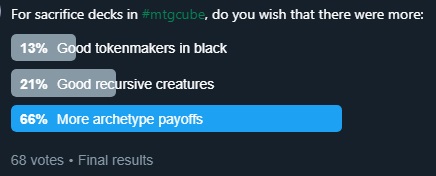
While creatures like Bloodsoaked Champion and Dread Wanderer are great, a deck like a Black midrange deck shouldn't be playing these as they're antithetical to the deck's game plan.
Example Deck #9 | Cube | Usman Jamil
- Creatures (15)
- 1 Doom Whisperer
- 1 Dryad Militant
- 1 Eternal Witness
- 1 Gifted Aetherborn
- 1 Gravecrawler
- 1 Graveyard Marshal
- 1 Ishkanah, Grafwidow
- 1 Kraul Harpooner
- 1 Llanowar Elves
- 1 Myr Battlesphere
- 1 Ophiomancer
- 1 Primeval Titan
- 1 Reclamation Sage
- 1 Skinrender
- 1 Tarmogoyf
- Planeswalkers (3)
- 1 Garruk Relentless
- 1 Garruk Wildspeaker
- 1 Vraska, Golgari Queen
- Instants (4)
- 1 Assassin's Trophy
- 1 Beast Within
- 1 Diabolic Edict
- 1 Hero's Downfall
- Sorceries (1)
- 1 Chainer's Edict
- Artifacts (1)
- 1 Mox Jet
- Lands (15)
- 7 Forest
- 7 Swamp
- 1 Treetop Village
(From talking with the deck's pilot, Myr Battlesphere wasn't drawn and would have been better as a literal ham sandwich that cost 5> mana, given the deck's game plan.)
That being said, it isn't a card that's solely for decks with disposable and recursive bodies, since I've found that it can just get rid of things that are no longer needed for card draw like excess lands or irrelevant bodies. Sometimes it's fine to just not sacrifice anything for + loyalty. Because of this, I've found that she doesn't need a sacrifice theme or anything like that... but it helps and is a solid Golgari card.
Charnel Troll is a big threat but requires too much setup to be worth it. It can do things if specifically built around or as a way to diversify Golgari from being a pile of value spells and removal effects, but it still just lags behind the usual options.
Ral, Izzet Viceroy is much more of a fit for the 5-mana planeswalker trope mentioned earlier, and has some inconsistencies with its middle ability being poor at defending itself in the early stages of the game. Its + ability fits the generic draw ability on 5-mana walkers, with some upside of the deck can take advantage of it, but I found that it was just poor - value Red spells were significantly better and this just played poorly.
Ionize is a "splashable" counterspell that can be played in decks splashing for Blue, but like many cards tagged as "splashable" I find that this generally isn't worth the payoff for splashing (on its own). It's mainly reserved for play in Izzet decks. It has weird tension with ![]()
![]() 's overall plan, as the controlling versions of Izzet don't usually care about the opponent's life total until closing the game out, which is why Undermine's Lava Spike upside was generally a mediocre upside.
's overall plan, as the controlling versions of Izzet don't usually care about the opponent's life total until closing the game out, which is why Undermine's Lava Spike upside was generally a mediocre upside.
Coming from someone who loves playing Izzet aggro so much that it's become an inside joke amongst my Cube group, I still find this to be more of a niche card than something that every Izzet deck would want. The more boring Izzet damage decks like Electrolyze, Izzet Charm and its ilk are better, as are its existing non-boring cards like Dack's Duplicate and whatnot.
League Guildmage is the only really good guildmage of the set since its modes tend to work best with the guild's game plan. Its Blue mode is better than Dimir Guildmage's ability (requiring to tap is significantly better than sorcery speed + ability to use more than once, since it requires so much mana to use once) and the Red ability can help to double up on cheap spells, like burn. I found it required having a few too many things to align to really work well and the more generic aforementioned Izzet cards are better.
Knight of Autumn is best non-hybrid Selesnya card. Like Sprouting Renewal, this is another great card to deal with artifacts and enchantments while being a great card with a ton of utility when a Naturalize isn't needed. Play this.
Trostani Discordant is an odd riff on cards like Regal Caracal and go-wide anthem-style effects.
Her ability to help work against Control Magic types of effects is a nice side bonus, but her overall impact isn't enough.
Emmara, Soul of the Accord operates somewhat similarly to Precinct Captain as a threat that can generate more threats. She has some positive interactions with vehicles and cards like Opposition; but, for the most part, she's a multicolored Precinct Captain. Because of this, she really suffers from having no evasion as a saboteur. She isn't a bad card, but Cubes will have a very hard time including her.
March of the Multitudes is Selesnya's take on Sphinx's Revelation, as a way to do something at end-of-turn to turn the game around. It works well with Selesnya's game plan since it can have issues since a lot of its game plan is casting things at sorcery speed, making them fall prey to instant speed removal or countermagic. Some cards like Restoration Angel and Archangel Avacyn do help, but White decks of all flavors want those cards. So, good luck getting one if not cracking one early.
March of the Multitudes isn't as good as Secure the Wastes as it's harder to value cast it for a few creatures, but I found that it's not hard for it to be cast for 10+ creatures in drawn out games. It's a solid card in a color with a lot of solid, non-embarrassing cards in a guild that's filled with many such cards, but since it operates on a different axis than many others, I've liked it in Cube thus far. Knight of Autumn may be the queen of Selesnya, but March of the Multitudes isn't too far behind.
Aurelia, Exemplar of Justice - From Agrus Kos, Wojek Veteran to Legion's Initiative, these types of cards that boost Red and White cards tend to boost Red creatures with power and White creatures with a boon that is significantly less good than power. The new Aurelia is no exception to this mold.
Being a 2/5 flyer for 4 is decent, and at worst tends to fly in for 4 vigilant trample damage. Her ability to grant a buff to other creatures does get around some issues that giant stat monsters have, in that she has an immediate impact. Generally, though, it's much better for a Red creature to get +2/+0 and trample rather than vigilance. Because of this, there weren't as many instances of her being splashed in something like a base-White deck as she was usually in more heavy Red decks or straight-up Boros decks. She does a lot and I found that it wasn't uncommon for her to be read and to hear something like "Oh, she has flying too?" or "Oh, she can mentor too?" She wasn't typically played in decks that wanted her on defense, but I found it was nice when she could play both sides of the battlefield when she could buff herself, which made her an all-in-all solid card, even if she was in a spot where White and Red both have an embarrassment of riches.
Tajic, Legion's Edge packs a lot as a pure stat monster, similarly to Aurelia; but, oddly, I found that he had the problem of just running headlong into 2/2s on turn three. When I thought about it, it felt inconsistent considering how Najeela had that potential problem (and didn't have haste, to boot) but it felt like Najeela's ability to snowball damage made up for it. The ability to stop non-combat damage was nice in Red matchups but useless otherwise and the ability to trigger first strike was a real mana cost.
This isn't to say that I think he's bad since a 3/2 with haste, mentor, and a few other abilities is hardly "bad" and such reductive language tends to stifle critical thought. I just found that he didn't seem to live up to the expectations that I had him for him. He's still pretty solid as a nice beater for aggro decks, but temper expectations accordingly, as I found Aurelia to perform better than Tajic.
Swiftblade Vindicator is like many other 1/1 double strikers like Fencing Ace and Viashino Slaughtermaster, where the payoff for boosting it is absurd since it can deal so much damage, but it's anemic when not boosted. These 1/1 double strikers generally don't tend to work in Cube, since they act closer to a Goblin Piker if they're unbuffed and this is no exception, even with Trample and Vigilance.
Deafening Clarion is fine as a small wrath that can be "splashed" in a White deck or a Red board control deck. It giving lifelink is unique because it can help to buffer a big life swing if the deck has leftover creatures that can survive the 3 damage to all creatures and can attack.
It was found to be fine, although it was mainly a Firespout type of small wrath where the lifelink was chosen sometimes but it wasn't enough of an upside to push it into the high ranks of Boros cards. Multicolored cards really needs to do a lot more than its mono-color counterparts to make up for it costing two colors and even without taking color cost, I've personally liked Sudden Demise and Sweltering Suns more. Having only one ![]() or
or ![]() in the cost does allow it to be splashed in a board control deck, but it's hardly top-tier.
in the cost does allow it to be splashed in a board control deck, but it's hardly top-tier.
Thief of Sanity is an obvious Nightveil Specter riff and, although it can't get lands, I've found that its ability to choose between 3 cards and the ability to use the card, even if it leaves the battlefield more than makes up for it. The last part separates Gonti, Lord of Luxury from unplayability to solid card.
While Thief of Sanity can miss when hitting an opponent, generally I've found this fear to be unfounded. I've found that it usually changes the flow of the game, requiring the Thief to be killed very soon or it'll bury the opponent in card advantage. Two hits usually is a big shift toward winning the game. Thief of Sanity fails the "Terminate test", but slighting the 3-mana Thief of Sanity for that is a poor method of evaluation. Because of that, I've found Thief of Sanity to be a pretty top-tier Dimir card.
Lazav, the Multifarious is a weird Omenspeaker variant that can roadblock early creatures and one that can just happen to change from a Maritime Guard to a Titan in the late game. In Cube, there aren't many Cubeable creatures that have drawbacks upon casting/entering the battlefield aside from Demon of Catastrophes, and since it doesn't copy Mulldrifter style creatures' enter-the-battlefield triggers, it's a lot worse spending five mana to turn your 1/3 into a 2/2 flier. It's not bad for getting value for the late game but I found that it's just too expensive to metamorphose into other creatures in your grave.
Etrata, the Silencer is a weird Nekrataal type of creature but one that takes too long to get much mileage out of it. Attempting to get multiple uses out of it is a pipe dream. In decks like control, attacking can be awkward since it makes it act like an miser's Vraska's Contempt. It's overrated due to the uniqueness of her ability and not really worth the Dimir Cube slot.
Mnemonic Betrayal is hard to take advantage of, even with highly efficient and cheap Cube cards. Like Yawgmoth's Will, it can "value will" by being able to get a bunch of random cards from the opponent's graveyard but I found having to rely on your opponent to make this worthwhile was too much of a stretch, since it required either lucking out and hitting an absurd card from the opponent's graveyard or hoping to hit a bunch of cheap cards from the opponent's graveyard. Ultimately, this had too little overall payoff.
Underrealm Lich reminded me of Tomorrow, Azami's Familiar as a way to sculpt draws, albeit with a bigger body, along with a way to protect itself and to protect you against mill, if need be. Underrealm Lich gets some value from Black and Green both having a shallow pool of good 5-drops. I mainly tried it based on @DrRuler's impression that it's good (it's not bad, but at least plugs up a weakness for the shallowness at 5 in the Golgari colors) and insistence that it's better than Vraska, Golgari Queen (it definitely isn't.) Generally, it's a fine creature but not one that's going to pull someone into Golgari or to splash for it, but also not embarrassing in the final 40 of a Golgari deck.
Split // Hybrid Cycle
This cycle was developed with the idea of being situationally useful for an overall powerful effect:
[card]Connive // Concoct" href="/p/Magic+The+Gathering/Connive // Concoct" href="/p/Magic+The+Gathering/[card]Connive // Concoct">[card]Connive // Concoct">Connive // Concoct" href="/p/Magic+The+Gathering/[card]Connive // Concoct">[card]Connive // Concoct is the best of the bunch as a small Control Magic type of effect that steals creatures with low power. I found that even though both Black and Blue could play the mode, not many decks were interested in the small wrath effect. It also felt like too little, too late for the theft effect to really make much of an impact in Cube decks. It was too slow against aggro and its best role was if you lucked out and stole a high-impact small creature that wasn't a Mulldrifter (like an Ophiomancer or a Metalworker). The stars needed to align right. The multicolored mode was also just too "fair" and clunky to use. Dimir's got some great cards and while there still isn't a clear winner for Dimir sections, this didn't seem to compete very well.
Find // Finality's best mode was the first mode as a 2x Raise Dead, which wasn't bad for a unique effect. Generally Raise Dead effects aren't represented too much in Cube (K Command, Lili Last Hope, various things like Reveillark) and having some good ones helps with sustainability in the late game, but I found that mostly Black decks wanted this. The Finality mode, however, was too expensive. If playing this in your Cube, like with Death in Life // Death, consider it mainly for the Black side, not the two-color package.
Expansion // Explosion was just too expensive and limited in use. There aren't a lot of high-mana payoffs in Standard, which makes this look like a Sphinx's Revelation. Coming from someone who had good initial vibes from Sphinx's Revelation, this is a big step away from that.
XXYY Cycle
None of these do enough to really make up for their incredibly awkward costs. The same applies to Niv-Mizzet, Parun, whose incredibly awkward ![]()
![]()
![]()
![]()
![]()
![]() cost is prohibitive for Cube, especially since it (mostly) fails the Terminate test.
cost is prohibitive for Cube, especially since it (mostly) fails the Terminate test.
Chamber Sentry was mostly a scalable 1-3 mana creature with Sunburst/Converge for artifact decks and stuff like Najeela. I've never seen this activated for ![]()
![]()
![]()
![]()
![]() , but most of the card's use is in the other modes.
, but most of the card's use is in the other modes.
While Chamber Sentry can ping off annoying creatures if need be, it's slow and clunky at that and like Bounty Agent, telegraphs it due to needing to tap to use it.
Good artifacts tend to generally trend more toward the non-aggro spectrum and aggressive artifacts, as great as they are, aren't very numerous in Cube. As I've personally been pushing aggressive artifact strategies, this initially piqued my interest but it ended up being the very definition of mediocre filler and it was a card that few decks were excited to play.
Generally it was a filler creature; while most colorless cards tend to lean toward big mana things. I found this to be replaceable, even with my Cube's recent pushes toward artifact strategies.
The locket cycle is the "you" part of the "you vs mana rock she told you not to worry about." Don't play these. Just don't.
Thanks for reading!
My blog, featuring my Pauper, Peasant and powered Cube lists
Cube podcast, The Third Power, that Anthony Avitollo and I host.
Find me on Twitter @UsmanTheRad



















